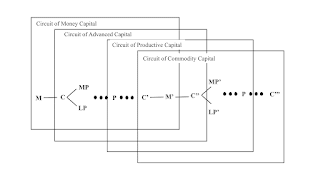The Four Circuits of Capital Marx describes three circuits of capital in the opening chapters of Volume 2 of Capital. But when I draw a diagram, as above, a fourth circuit seems to be missing. So I have added the circuit of advanced capital. The circuit of advanced capital begins with commodities, consisting of means of production and labor power, in the hands of or under the direction of capitalists. They have purchased these commodities with monetary advances. The capitalists, at this point, care about the use values of these commodities, and they have purchased them to be in specific proportions. The sphere of circulation is left behind in the next step in the circuit. Workers apply labor to the means of production, under the formal and real subsumption of capital, to produce
Topics:
Robert Vienneau considers the following as important: Karl Marx
This could be interesting, too:
Robert Vienneau writes The History Of No-Longer-Existing Socialism Validates Marx
Robert Vienneau writes William Baumol On Marx
Robert Vienneau writes Francis Spufford On Commodity Fetishism As A Dance
Robert Vienneau writes A Derivation Of Prices Of Production With Linear Programming
| The Four Circuits of Capital |
Marx describes three circuits of capital in the opening chapters of Volume 2 of Capital. But when I draw a diagram, as above, a fourth circuit seems to be missing. So I have added the circuit of advanced capital.
The circuit of advanced capital begins with commodities, consisting of means of production and labor power, in the hands of or under the direction of capitalists. They have purchased these commodities with monetary advances. The capitalists, at this point, care about the use values of these commodities, and they have purchased them to be in specific proportions.
The sphere of circulation is left behind in the next step in the circuit. Workers apply labor to the means of production, under the formal and real subsumption of capital, to produce another set of commodities. These commodities consist of both means of production and means of consumption, depending on the department in which a capitalist operates. But the capitalists do not care about use values at this point. The commodities are, for him, values.
In the next step, the capitalists sell produced commodities for money. That is, values are realized. Money need not be cash or coins. Some capitalists might sell commodities to other capitalists for bills of exchange. Realized value includes surplus value, added by workers but not paid out in wages.
Although not shown in my diagram above, capitalists may use some of the money they have obtained to purchase necessaries and luxuries. But some money is used to complete the circuit, by purchasing means of production and labor power. Usually, one would expect this completion to allow the circuit to continue on an expanded scale.
The time of turnover of capital is the sum of the time of production (including, for example, time for aging processes in which labor is barely expended) and the time of circulation. In some sense, the time of circulation does not enter the circuit of commodity capital. The industrial capitalist can realize the value of produced commodities by selling to merchants, not directly to consumers, and thereby continue the circuit. But the time of the circulation does enter into the three remaining circuits, that of the circuit of money capital, the circuit of advanced capital, and the circuit of productive capital.
The circuits of capital emphasize that, for Marx, capital is a process for extracting surplus value. Capital is neither money; physical commodities, whether means of production or labor power; nor produced commodities. It is all of these in a social process, where one embodiment of capital follows another.
(I have been reading Resnick and Wolff. They draw on Louis Althusser and emphasize a over-determined, process-oriented reading of Marx. I do not see how one gets much in the way of quantative results from this reading, but their qualitative results can be of interest.)
- Resnick, Stephen A. and Richard D. Wolff. 2006. New Departures in Marxian Theory. Routledge.
 Heterodox
Heterodox

